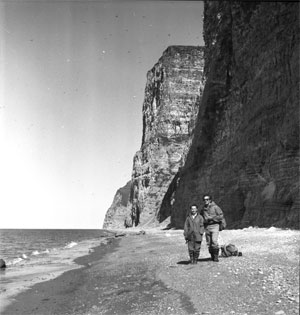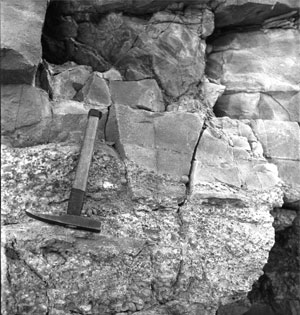Ugol'naya Bay
| Early Ginter Floral Phase | Grebenka Floral Phase | Barykov Floral Phase | Amaam Lagoon | NE Russia Map | Field Photos |
|---|
| Fossil Images |
Lithology and StratigraphyExposed in Ugol'naya Bay (NE Russia) are interbedded Albian to Upper Cretaceous marine and non-marine deposits that accumulated in coastal lowlands and a shallow marine basin. Overlying and angularly disconformable with terrigenous volcanogenic rocks of Berriasian-Valanginian age is the Ginter Formation. This is divided into four lithologic members members (Pergament, 1966, 1978): 1) conglomerate-sandstone, 2) sandstone, 3) coaly, and 4) clayey-aleurolite. The total thickness of the formation is about 650 m. According to Pergament (1978), the lower part of the Ginter Formation (the conglomerate-sandstone and the bulk of the sandstone members) contains no mollusc remains. These deposits are assumed to correspond to the Lower Cenomanian (Inoceramus aff. crippsi - Desmoceras kossmati regional zone), while the basal part of the conglomerate-sandstone member is probably of Late Albian age. The upper beds of the sandstone member, the coaly member and the lower part of the clayey-aleurolite member are assigneg by Pergament (1978) to regional (local) zone Inoceramus pennatulus (Middle Cenomanian). From these deposits the remains of marine molluscs Turrilites costatus Lam., Inoceramus pennatulus Perg., I. pennatulus interjectus Perg., I. ginterensis Perg., I. aff. ginterensis, Metatrigonia (Apiotrigonia) sp. etc. have been collected (Pergament, 1978). The upper (and greater) part of the clayey-aleurolite member contains numerous fossil Inoceramus nipponicus (Nag. et Mat.), I. reduncus Perg., I. gradilis Perg., I. scalprum Boehm., I. tenuis Mant., I. beringensis Perg., I. dunveganensis McLearn etc. and was assigned by Pergament (1978) to the upper zone of the Cenomanian, i.e. the regional zone I. nipponicus - I. scalprum. Terekhova (1988) and Pokhialainen (personal communication to A.B. Herman) consider the zone I. nipponicus to be of Late Cenomanian - Early Turonian age. The Ginter Formation is overlain by the Barykov Formation with a stratigraphic and slight angular (?) discordance. The Barykov Formation is divided into four lithologic members (Pergament, 1971, 1974, 1978). The lower sand-clayey member is regarded as being Coniacian in age based on the presence of Inoceramus stantoni Sok., I. verus Perg., I. involutus Perg., and Gaudryceras aff. stritum Jimbo. The thickness of the member is about 200 m. The overlying sandstone-tuff member, as thick as 350 m, has yielded remains of Inoceramus cf. undulatoplicatus Roemer, I. transpacificus aff. transpacificus Perg., I. naumanni Yok., Pachydiscus sp. etc. indicating an Early Santonian age. The superadjacent aleurolite-sandstone member contains fossil Inoceramus transpacificus transpacificus Perg., I. transpacificus ramosus Perg., I. transpacificus aff. angustus (Beyenburg), I. ex gr. patootensis Loriol. and others. These taxa suggest that this member, whose thickness is around 520 m, is Santonian or, possibly, Lower Campanian in age. |
Geologic map of the Ugol'naya Bay area, N.E. Russia showing positions of the main plant localities.
Stratigraphic and lithological chart of rocks exposed in Ugol'naya Bay, N.E. Russia. |
||||||||||||||||
The Barykov Formation terminates in a coaly member consisting of three parts: a lower coal-bearing part, a middle part devoid of coal, and an upper coal-bearing part. Both the coal-bearing parts contain numerous plant impressions while the middle strata, devoid of coal, have yielded few Inoceramus ordinatus ordinatus Perg., I. anadyrensis hastatus Perg., I. aff. schmidti (Michael). The total thickness of the coaly member is about 170 m. The Barykov Formation is concordantly overlain by the Koryak Formation, the lower part of which has yielded, amongst others, Inoceramus ex gr. schmidti (Michael), I. sachalinensis sachalinensis (Sok.), I. elegans elegans Sok. The age of this part of the formation is regarded as being Campanian, while that of the overlying Koryak Formation (thickness as much as 500 m), as Campanian-Maastrichtian (Pergament, 1974, 1978). The Koryak Formation ends in a coal bed "Podsopochnyi" containing rare plant impressions of Sphenopteris sp., Thuja (?Mesocyparis) sp., Taxites cf. olrikii Heer, Phyllites sp. (Volobueva and Krasniy, 1979 and unpublished data of Herman). The Koryak Formation is overlain by the Chukotka Formation of Danian - Paleogene age. The lowermost strata of the Chukotka Formation may in all likelihood belong to the Upper Maastrichtian ("terminal" Maastrichtian according to Pokhialainen, 1994) since remains of an inoceramid prismatic layer and Parallelodon sp. have been found in these deposits in the Alkatvaam River basin (west of the Ugolnaya Bay area) (Dundo et al., 1974; Pokhialainen, pers. comm., 1994). Danian foraminifers Cyclammina akkeshiensis (Yosh.), Haplophragmoides kushiroensis Yosh., and Ammodiscus pennyi Cushm. et Yarv. have been found in sandy aleurolites of the lower Chukotka subformation, about 150 m above its base, in the area of Dlinnyi Stream (the northwestern coast of Ugolnaya Bay) (data of M.Ya. Serova: Volobueva and Krasniy, 1979). Thus, the plant-bearing deposits of the upper coaly member of the Barykov Formation lie stratigraphically above the beds of the Upper Santonian and, possibly, Lower Campanian and are overlain by Campanian strata; these plant-bearing deposits are therefore most probably Lower (or Lower - Middle) Campanian in age (see the stratigraphic column above). The FlorasThe Late Albian - Campanian deposits on the Ugol'naya Bay coasts contain three taphofloras (Herman, 1988a, 1988b, 1991) (rare plant fossils from the coal layer "Podsopochniy" should not be considered as a representative taphoflora). The Ginter FloraThe Late Albian Early Ginter Flora from the basal conglomerate-sandstone member of Ginter Formation is of a low taxonomic diversity (about 10 species) and includes ferns Hausmannia ex gr. bilobata Prynada, Hausmannia sp., Cladophlebis aff. williamsonii (Brongn.) Brongn., Sagenopteris sp. indet., the cycadophytes Nilssonia (?) sp., and Neozamites sp., as well as conifers such as Podozamites sp. indet., and Phyllites sp. (Yefimova and Terekhova, 1966). In addition, remains of Cladophlebis sp., Sphenopteris (?) sp., Pityophyllum sp., and Desmiophyllum sp. were collected by Herman in 1990 from these deposits. This compositionally impoverished floristic complex, according to Yefimova and Terekhova (1966), bears witness to the probable Albian age of the lower strata of the Ginter Formation: it includes Early Cretaceous plants only and has no angiosperms (Herman, 2011). The Middle Ginter Flora (Herman, 2011; Moiseeva, 2010) from a middle (coaly) member of the Ginter Formation is dated as mid-Cenomanian because marine deposits underlying and overlying the plant-bearing beds belong to the Inoceramus pennatulus regional biozone. The flora (29 species) is dominated compositionally by angiosperms (35%) and conifers (28%). Ferns are moderately abundant (18%), as are ginkgoes (11%), but horsetails (4%) and cycadophytes (4%) are less common. Among the ferns, Coniopteris grebencaensis, Onychiopsis elongata and Birisia jelisejevii are the most ubiquitous. Cycadophytes are represented by Nilssonia yukonensis, conifers by Athrotaxopsis cf. expansa, Cephalotaxopsis heterophylla, Sequoia reichenbachii, S. fastigiata, Podozamites lanceolatus and Elatocladus cf. smittiana. Among the angiosperms Menispermites marcovoensis, M. ginterensis, Grebenkia anadyrensis, Dalembia vachrameevii, Dalbergites elegans and Ettingshausenia cf. louravetlanica predominate, whereas Araliaephyllum, Cissites and Dicotylophyllum are rare. It is coeval with the Grebenka Flora. The Barykov FloraThe Ginter Formation is overlain by the Barykov Formation that is subdivided into four lithological members. The three lowermost members are of marine origin and contain Coniacian - Santonian (? early Campanian) mollusk remains, and an upper (coaly) member contains numerous plant fossils as well as Campanian mollusk remains. This mid-Campanian Barykov Flora (Herman, 2011; Moiseeva and Sokolova, 2011) is very diverse (>70 taxa) and characterised by a predominance of angiosperms (>50%), followed by conifers (17%) and ferns (12%). Horsetails, ginkgoes and cycadophytes are less abundant. Among the angiosperms, platanoids (Arthollia, Paraprotophyllum, Ettingshausenia, Platimelis), 'Quercus' tchucotica and several species of Macclintockia, Cissites, Celastrinites, and Trochodendroides are abundant, whereas Magnoliaephyllum, Araliaephyllum, Viburniphyllum, Menispermites, 'Vitis' penzhinica and Quereuxia angulata are less numerous. The Ugol'naya Bay section contains the type taphoflora for Barykov phase of floral evolution. Field Photographs
|
|||||||||||||||||





